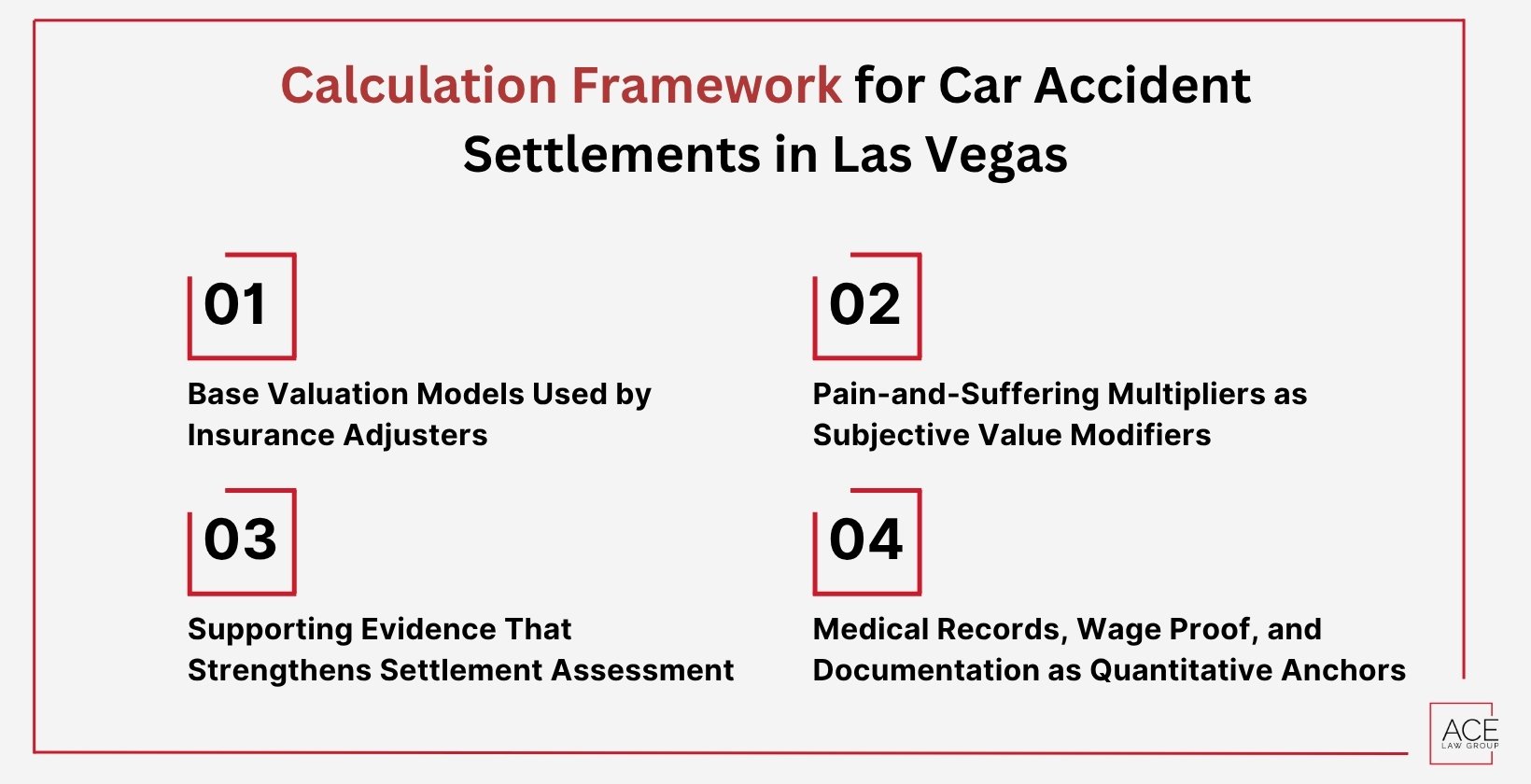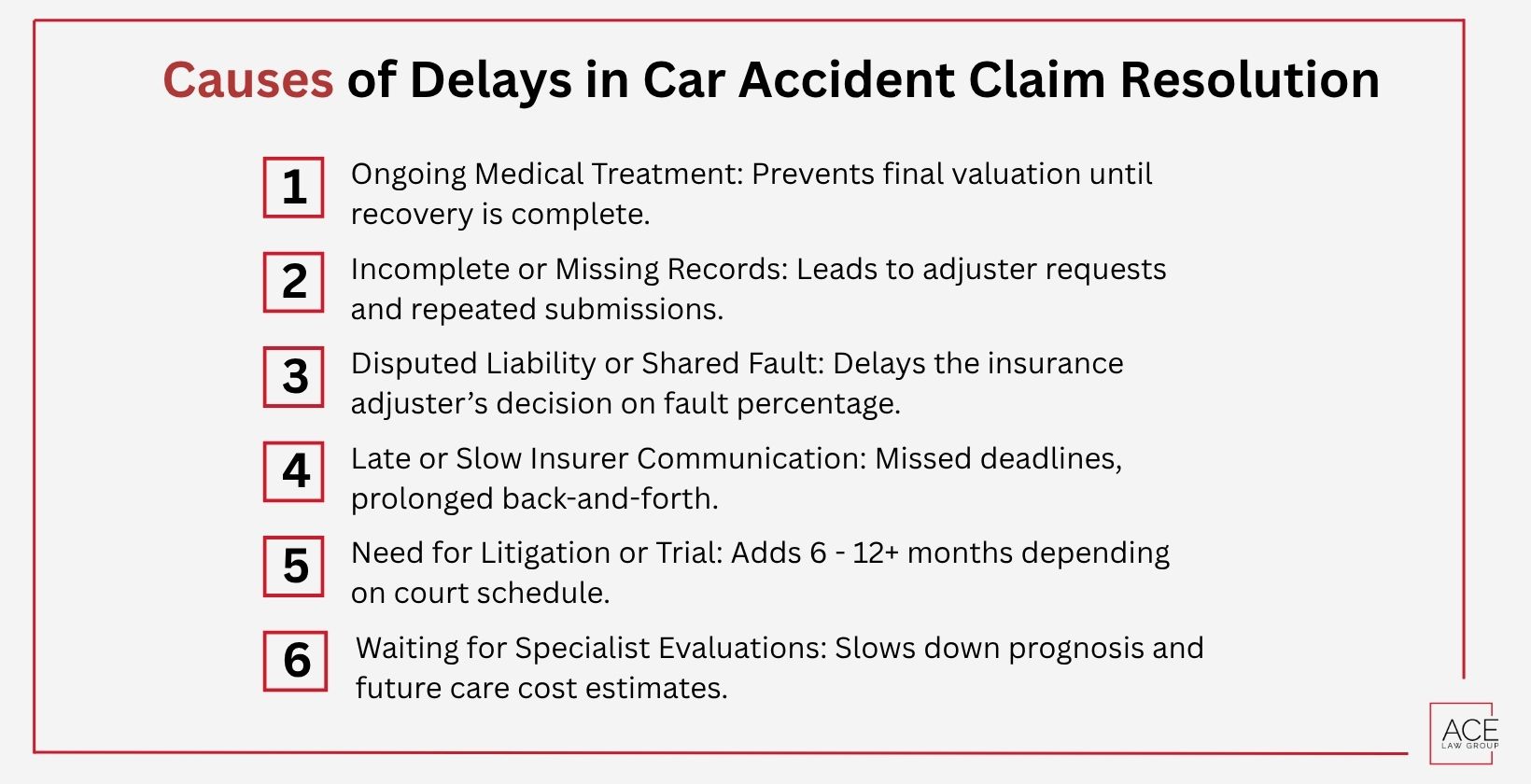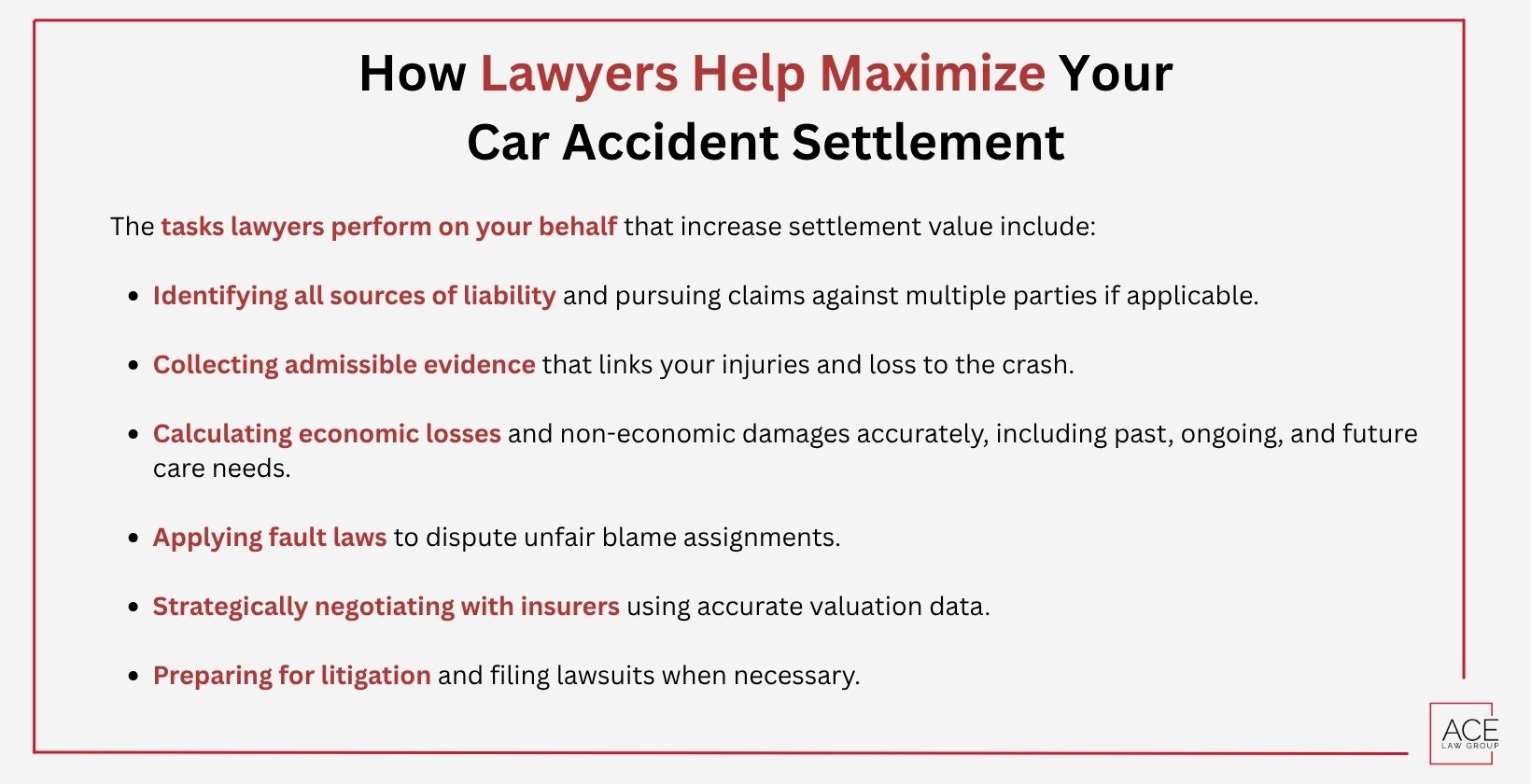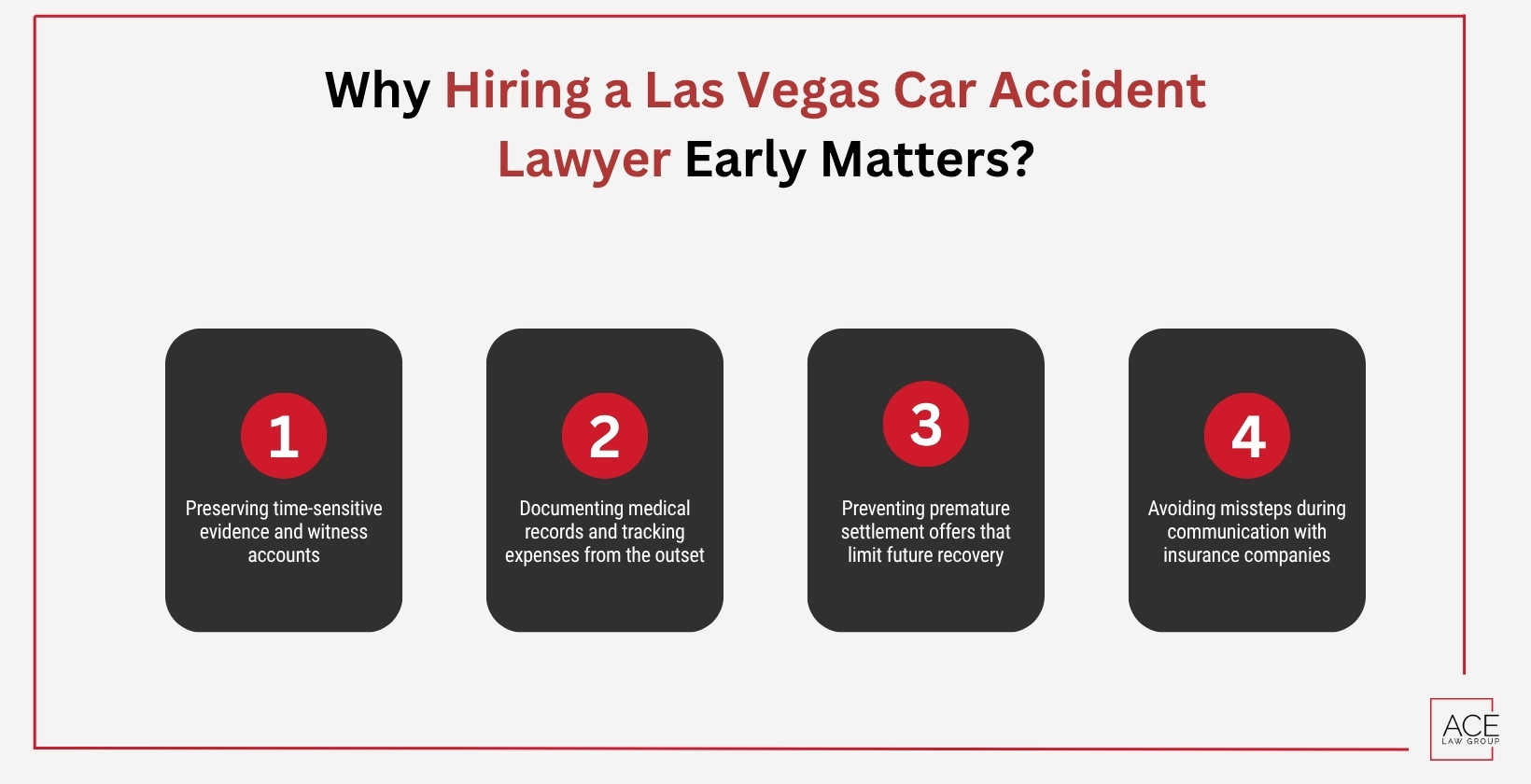Settlements in Nevada car accidents vary widely, from a few thousand dollars to seven figures, depending upon the state’s fault laws, local insurance practices, and the unique nature of each crash. There is actually no specific or “average” car accident settlement in Las Vegas.
Unlike no-fault states, Nevada holds the at-fault driver legally and financially responsible for damages. That means the total payout depends heavily on evidence that proves fault, the severity of injuries and damages, the extent of expenses related to the crash, and the availability of insurance coverage.
Recent Case Result
We secured a $4.8 Million settlement for a client injured in a car crash.
Our legal team fought to recover full compensation for medical expenses, lost wages, and pain and suffering.
Call Us Now: (702) 333-4223How Much Are Car Accident Settlements Worth in Nevada?
As experienced Las Vegas car accident lawyers, we’ve consistently resolved local traffic crash cases that typically range from a few thousand dollars for minor accident injury claims to several million dollars in catastrophic or wrongful death cases.
Why Car Accident Settlement Values Vary in Nevada?
No two accident claims and their outcomes in Nevada are identical. Las Vegas settlements often trend higher than those in rural areas due to the frequency of traffic crashes, higher medical costs, increased insurance premiums, and more contested claims.
For example, a soft-tissue injury case in Reno may settle for $10,000, while a similar claim in Las Vegas may exceed $20,000 due to differences in hospital billing, income, property valuation, or urban insurance tactics.
These highlight why vehicle accident settlements differ and why average settlement amounts are not reliable benchmarks without context.
Typical Settlement Amounts in Las Vegas Car Accident Claims
While two accidents may look similar on the surface, outcomes often differ based on location-specific details like the traffic volume, legal environment, and the economic realities of the city.
Local data shows that the average minor car wreck settlement involving bodily injuries often reaches $25,000, while severe cases involving permanent disability or extensive medical treatment may exceed $500,000. In extreme cases, verdicts and settlements have reached into the millions.
Settlement Range by Injury Severity: Minor to Catastrophic Cases
Settlement value often tracks directly with injury severity, since more serious injuries require longer treatment, more time off work, and greater long-term care. The table below outlines how injury level affects settlement amounts and resolution timelines.
| Injury Level | Common Injuries | Settlement Range | Claim Duration |
|---|---|---|---|
| Minor | Whiplash, sprains, soft-tissue | $3,000 – $25,000 | 1 – 3 months |
| Moderate | Fractures, concussions, surgeries | $25,000 – $150,000 | 3 – 9 months |
| Catastrophic | Brain injury, paralysis, loss of limb | $250,000 – $1M+ | 9 – 24+ months |
Las Vegas-specific factors increase claim value and can also lengthen the claim timeline, especially when multiple providers or hospitals are involved.
Key Factors That Determine the Value of a Nevada Car Accident Settlement
A combination of legal rules, injury documentation, and financial limits shapes every car accident settlement in Nevada. The final payout depends not only on what was lost but also on how clearly those losses are proven and how much fault each party shares.
Below are the 5 primary elements that determine settlement value under Nevada injury law.
1. Injury Severity and Long-Term Medical Impact on Settlement Value
The more serious and long-lasting the injury, the higher the potential compensation. Claims involving surgeries, long-term rehabilitation, or permanent impairment often collect higher payouts due to increased medical expenses and loss of future earning capacity.
| Injury Type | Financial Impact |
|---|---|
| Soft-tissue injury (e.g., whiplash) | $3,000 – $25,000, typically resolved quickly |
| Fractures, moderate trauma | $25,000 – $150,000, includes surgery or rehab |
| Catastrophic injury (e.g., TBI, paralysis) | $250,000-$1M+, long-term care costs |
The presence of chronic pain, limited mobility, or future medical needs significantly raises both economic and non-economic damages. In these cases, the medical prognosis and cost of ongoing care are often central to valuation.
2. Property Damage and Vehicle Loss as Financial Determinants of Compensation
While insurers often focus on injury-related damages during settlement negotiations, the extent of property damage represents both a direct financial loss and provides necessary context for the claim. Repair costs, diminished vehicle value, and total loss estimates become measurable economic factors that insurers include in their assessment.
More importantly, visible vehicle damage strengthens the credibility of the injury claim, as it helps establish the force of impact and causation. Higher-impact collisions are more likely to cause serious bodily injury and substantial damage to the vehicle and any personal property inside.
3. Liability Distribution and Comparative Fault in Nevada Claims
Nevada applies a modified comparative negligence rule (NRS 41.141), which reduces your compensation by your share of fault. If you are found 51% or more at fault, you cannot recover any damages.
Here’s a tabular breakdown to clarify settlement amounts based on your share of fault:
| Fault Percentage | Compensation Eligibility | Example |
|---|---|---|
| 0% | 100% recovery | $100,000 settlement stays $100,000 |
| 25% | 75% recovery | $100,000 becomes $75,000 |
| 51%+ | No recovery allowed | Settlement barred |
Insurers often dispute fault to reduce liability, which is why accident reconstruction, police reports, and witness statements are critical to proving liability and your share of responsibility.
4. Insurance Coverage Limits and Policy-Based Recovery Caps
Insurance policy limits set the ceiling for payout in most Nevada car crash claims. If the at-fault driver carries only the state minimum liability insurance coverage, then that amount may be the maximum recoverable from their insurer, even if actual losses exceed that limit.
| Policy Type | Coverage Limit | Recovery Implication |
|---|---|---|
| Nevada State Minimum |
$25,000 for bodily injury per person $50,000 for total bodily injury per accident $20,000 for property damage per crash |
Recovery is often capped at policy maximum |
| Full Coverage | Varies by insurer, typically $100K+ | Allows higher payouts, including under UM/UIM |
| Uninsured/Underinsured (UM/UIM) | Based on your own policy | May cover excess if the at-fault driver is underinsured |
5. Economic and Non-Economic Damages as Core Valuation Metrics
Nevada settlements reflect both economic and non-economic losses, calculated either separately or through a multiplier method. Economic damages include tangible financial losses, while non-economic damages reflect pain, suffering, and life disruption directly related to the crash.
Below are the major economic and non-economic damages covered:
| Economic Damages | Non-Economic Damages |
|---|---|
|
Medical expenses Future medical costs Lost wages and earning capacity Property repair/replacement Out-of-pocket expenses |
Pain and suffering Emotional distress Loss of enjoyment of life Loss of consortium Disfigurement or scarring |
Calculation Framework for Car Accident Settlements in Las Vegas
To determine the value of a car accident claim, insurance companies use structured calculation models. These frameworks combine verified economic losses with subjective factors such as pain, treatment duration, and the long-term impact of crash-related injuries.
While each insurer might use internal tools or proprietary systems, most car accident settlement calculations follow a two-part approach: quantifying direct financial harm and applying modifiers based on legal, medical, and evidentiary factors.
Base Valuation Models Used by Insurance Adjusters
The valuation starts with a base value built from objective, quantifiable losses. This includes medical bills, lost income, and vehicle damage. Most insurers rely on internal software to assign values based on injury codes, treatment types, and diagnostic timelines.
Here’s a breakdown of the considered base valuation components:
| Component | Basis of Calculation | Weight in Total Value |
|---|---|---|
| Medical Bills | Verified treatment costs and billing documentation | High |
| Lost Wages | Pay stubs, employer letters, tax returns | Moderate to high |
| Property Damage | Repair estimates, vehicle replacement, ACV | Moderate |
This calculated total forms the economic foundation of the claim before any pain-and-suffering or non-economic modifiers are applied.
Pain-and-Suffering Multipliers as Subjective Value Modifiers
Non-economic damages are typically calculated by multiplying economic losses by a severity-based multiplier. The multiplier reflects injury impact, recovery time, emotional strain, and long-term impairment.
| Injury Severity | Typical Multiplier Range |
|---|---|
| Minor | 1.5x-2x |
| Moderate | 2x-3.5x |
| Severe | 4x-5x+ |
For example, economic losses totaling $30,000 could result in a total claim value ranging from $90,000 to $150,000 using a 3x to 5x multiplier. Multiplier range varies based on the injury’s nature and the supporting documentation.
Supporting Evidence That Strengthens Settlement Assessment
Insurers assign higher value to claims supported by consistent evidence that validates the injury, clarifies liability, and proves financial impact. Key evidence types include:
- Medical treatment and imaging records
- Police crash reports and fault diagrams
- Photos of the vehicle and physical injuries
- Witness statements and scene descriptions
- Expert opinions and long-term care assessments
The evidentiary strength of a claim often determines the credibility of the multiplier and influences insurer negotiation strategy.
Medical Records, Wage Proof, and Documentation as Quantitative Anchors
Quantitative documentation, such as medical and financial records, establishes the scope of loss and links injuries directly to the crash. Without these, neither courts nor insurers can justify a full-value payout.
| Medical Documentation | Financial Documentation |
|---|---|
| ER and hospital records | Wage statements, pay stubs |
| Diagnostic reports (MRI, CT) | Tax returns, employer verifications |
| Treatment and rehab notes | Lost benefit and PTO statements |
| Prescription logs and referrals | Evidence of reduced earning capacity |
These documents serve as anchors for both economic valuation and any pain-and-suffering multiplier. Consistency, clarity, and medical corroboration significantly increase the final settlement amount.

Settlement Duration and Resolution Timelines for Nevada Car Accident Claims
A car accident settlement timeline in Nevada depends on a mix of multiple factors: the complexity of the case, medical recovery, evidence development, and insurer responsiveness.
While claims with clear liability or consistent documentation resolve within a few months, others involving serious injuries or disputed liability can take a year or more. In urban areas like Las Vegas, court congestion and insurer caseloads may also contribute to longer settlement windows.
Average Timeframe for Car Accident Settlements in Las Vegas
We have resolved most Las Vegas car accident settlements typically within 3 to 9 months, depending on the nature of the case. However, claims involving long-term medical care, contested fault, or litigation frequently extend to 12 – 18 months or longer.
| Case Type | Typical Duration | Primary Variables That Influence Settlement Duration |
|---|---|---|
| Property damage only | 1 – 2 months | Clear liability, fast adjuster response |
| Minor injuries, no litigation | 3 – 6 months | Medical release, full documentation |
| Moderate to severe injuries | 6 – 12 months | Ongoing treatment, possible negotiations |
| Cases proceeding to trial | 12 – 24+ months | Court backlog, depositions, formal discovery |
Note: Nevada insurers must respond to claims within a reasonable time under NAC 686A.675, but resolution depends largely on how fast liability and total damages can be proven.
Common Causes of Delays in Car Accident Claim Resolution
Resolution of an accident claim can take an extended time due to several reasons for delay, including:
- Ongoing Medical Treatment: Prevents final valuation until recovery is complete
- Incomplete or Missing Records: Leads to adjuster requests and repeated submissions
- Disputed Liability or Shared Fault: Delays the insurance adjuster’s decision on fault percentage
- Late or Slow Insurer Communication: Missed deadlines, prolonged back-and-forth
- Need for Litigation or Trial: Adds 6 – 12+ months depending on court schedule
- Waiting for Specialist Evaluations: Slows down prognosis and future care cost estimates
Proactive legal follow-up and early evidence organization often prevent unnecessary delays. In complex cases, car accident settlement lawyers may initiate early settlement negotiations or file suit to maintain momentum.

Case-Based Settlement Outcomes from Las Vegas Car Accident Claims
While every case is unique, the following real case examples reflect trends seen in Nevada courts and pre-litigation resolutions. These show the influence of the type of collision, nature of the sustained injury, and local variables on final payout amounts.
Settlement Value Ranges Across Different Accident Types
Different crash types produce different injury profiles and different settlement outcomes. The following ranges reflect both medical complexity and how adjusters or courts assess liability in each scenario.
| Accident Type | Common Injuries | Typical Settlement Range |
|---|---|---|
| Rear-end Collision | Whiplash, back strain | $5,000 – $25,000 |
| Intersection T-bone | Fractures, concussion, chest trauma | $30,000 – $150,000 |
| Pedestrian Impact | Broken bones, head trauma | $100,000 – $500,000+ |
| Head-on Collision | Multiple fractures, internal injury | $75,000 – $250,000+ |
| Truck Involvement | Catastrophic injuries, TBI | $250,000 – $1M+ |
High-Value Settlements Involving Severe or Catastrophic Injuries
Catastrophic injury cases in Las Vegas often result in multi-six-figure or million-dollar settlements, especially when supported by long-term care plans, life-altering impact, and clear liability.
| Injury Type | Settlement Value | Notable Case Context |
|---|---|---|
| Traumatic Brain Injury (TBI) | $750,000 – $2M+ | Pedestrian struck in a crosswalk, clear fault |
| Spinal cord injury/paralysis | $1M – $3M+ | Truck collision, extensive rehab required |
| Wrongful death | $500,000 – $5M | Head-on crash, surviving dependents |
These claims often include non-economic multipliers, future care projections, and loss-of-life calculations. Documentation quality, ongoing medical needs, and expert testimony are critical in securing these higher-value outcomes.
Typical Compensation Amounts in Minor or Soft-Tissue Injury Cases
While minor injuries produce smaller payouts, they still account for a significant portion of claims filed in Las Vegas. Most involve temporary pain, medical treatment, and short-term work loss.
| Injury Type | Recovery Duration | Settlement Range |
|---|---|---|
| Whiplash | 2–4 weeks | $3,000 – $12,000 |
| Muscle strain/sprains | 2–6 weeks | $5,000 – $15,000 |
| Minor concussion | 2–8 weeks | $10,000 – $25,000 |
Insurers often apply low multipliers (1.5x – 2x) to medical bills for these cases, unless ongoing symptoms are well-documented. Prompt diagnosis and clear treatment records help support the value of otherwise straightforward claims.
Legal Rights and Comparative Negligence Under Nevada Law
Nevada car accident laws and liability rules govern the determination of fault and the compensation amount. These laws define who pays, how much, and under what circumstances. To protect your rights as a claimant, it’s essential to understand the state-specific negligence rule, the legal filing deadlines, and how these factors impact your final recovery.
How Nevada’s Modified Comparative Negligence Rule Works?
Nevada follows a modified comparative negligence rule under NRS 41.141. This law allows an injured party to recover damages only if they are 50% or less at fault for the incident. If their share of fault reaches 51% or more, they are legally barred from recovering any compensation.
How Shared Fault Reduces Your Potential Settlement?
If you share partial fault for a crash, your settlement will be reduced proportionally.
| Fault Percentage | Eligibility to Recover | Example |
|---|---|---|
| 0% – 50% | Yes | $100,000 reduced by fault share |
| 51% or more | No | The claim is barred under NRS 41.141 |
For example, if you are found 30% at fault in a case valued at $100,000, you are eligible to recover only $70,000.
Courts and insurers use on-site evidence, police reports, witness statements, and crash reconstructions to assign these percentages. This rule directly impacts your legal rights and should be considered early in the car accident lawsuit process.
Legal Deadline (Statute of Limitations) for Filing a Claim
Nevada law gives victims 2 years to file a personal injury claim under the car accident statute of limitations (NRS 11.190). For property damage claims, the deadline is 3 years from the date of the crash. If you fail to file within this deadline, you may lose the right to pursue compensation entirely, regardless of clear fault or severe injury.
How Lawyers Help Maximize Your Car Accident Settlement?
The value of your settlement largely depends on how well you prepare your case and how effectively you present it in negotiations. Legal representation improves settlement outcomes by employing legal strategy, uncovering additional sources of recovery, and challenging insurer bad-faith tactics.
The tasks lawyers perform on your behalf that increase settlement value include:
- Identifying all sources of liability and pursuing claims against multiple parties if applicable.
- Collecting admissible evidence that links your injuries and loss to the crash.
- Calculating economic losses and non-economic damages accurately, including past, ongoing, and future care needs.
- Applying fault laws to dispute unfair blame assignments.
- Strategically negotiating with insurers using accurate valuation data.
- Preparing for litigation and filing lawsuits when necessary.
The benefits of having legal support in your car accident case go beyond filing claims on time. It ultimately leads to higher compensation and faster resolution and protects you from claim denials, all while you focus on your recovery.
Ace Law Group stands ready to help maximize your car accident settlement with over 50 years of combined legal experience. Contact us for a free consultation.

Why Hiring a Las Vegas Car Accident Lawyer Early Matters?
The legal journey begins the moment the crash happens and results in bodily injuries and property damage, whether it’s a minor fender bender or a fatal crash. Hiring a reputable Las Vegas car accident lawyer early, preferably within a week, makes a positive difference in your claim by:
- Preserving time-sensitive evidence and witness accounts
- Documenting medical records and tracking expenses from the outset
- Preventing premature settlement offers that limit future recovery
- Avoiding missteps during communication with insurance companies

Car Accident Resources
How to Get Access to a Car Accident Report in Las Vegas?
Car Accident Determining Fault By Location of Damage
Recovering Lost Wages After a Car Accident in Las Vegas
Are Car Accident Insurance Settlements Taxable?
How to Settle a Car Accident Claim Without a Lawyer?
Causes of Car Accidents in Las Vegas
What Happens If You Total a Leased Car in Nevada?
Frequently Asked Questions About Car Accident Settlements in Las Vegas
How much of a $25,000 settlement will I actually receive?
You will receive the $25,000 settlement amount minus attorney fees, medical liens, and any unpaid treatment costs. In most Nevada cases, net recovery is between 60% and 75%, depending on your legal and medical arrangements.
What is considered a fair settlement offer after a car accident?
A fair settlement offer after a car accident is an amount that covers all economic losses (medical bills, lost income, and property damage) plus reasonable non-economic damages (emotional distress, pain, and suffering).
What if the at-fault driver’s insurance isn’t enough to cover my damages?
If the at-fault driver’s insurance isn’t enough to cover your damages, you may recover through your underinsured motorist coverage, if available, or sue the driver personally through a civil lawsuit for the remaining balance.
Can I still get a settlement if my injuries appear weeks after the accident?
Yes, you can still get a settlement if injuries appear weeks later, as long as you seek prompt medical care and a doctor links the injury to the crash. Delayed symptoms are common in crash injuries and are compensable in personal injury claims.
How long after a car accident can you expect to receive payment in Nevada?
You can expect to receive payment in Nevada within a few weeks after settlement is finalized, but the entire process may take 3 to 12+ months, depending on injury severity, insurer response, and documentation.
Does accepting a quick settlement affect my right to more compensation later?
Yes, accepting a quick settlement usually waives your right to further compensation, even if delayed injuries show up or your condition worsens. Always review settlement terms before signing, especially if you haven’t completed medical treatment or reached full recovery.
Do Nevada attorneys take most of your injury settlement?
No, Nevada attorneys typically take one-third (33.3%) of your injury settlement, unless your case goes to trial or involves exceptional complexity. Ethical rules require clear, written agreements outlining fee percentages and any case expenses.
What Your Nevada Car Accident Settlement May Really Be Worth?
There’s no universal formula for calculating the value of car accident settlements. Each case turns on a unique set of circumstances: who is at fault, how severe the injuries are, what proof exists, and how the law applies. Ultimately, while no two outcomes are identical, the patterns behind them are clear: well-supported claims backed by legal precision consistently recover more.